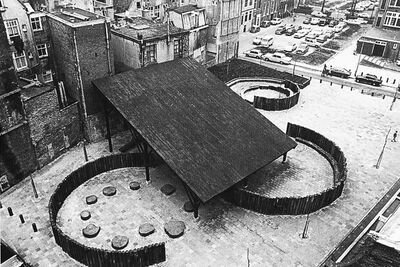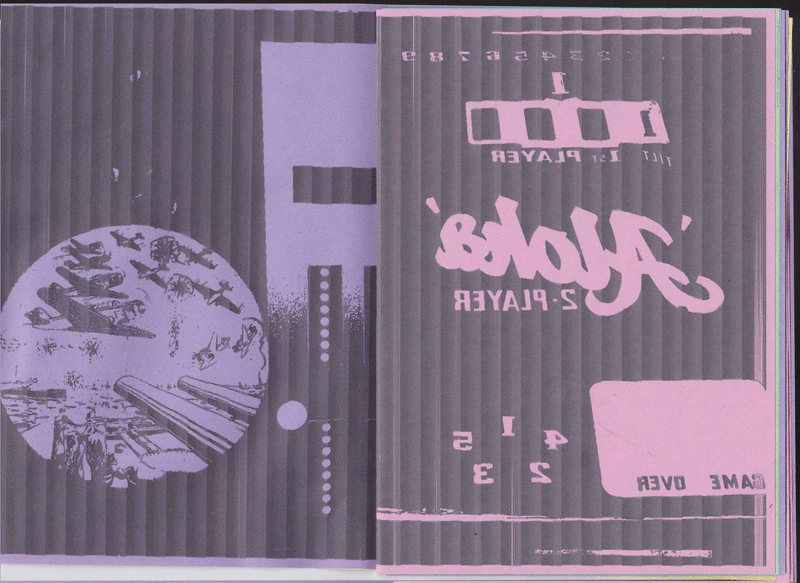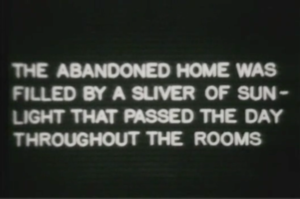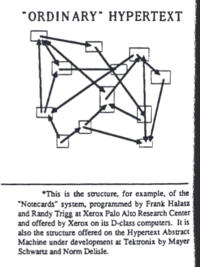User:Jacopo/st7: Difference between revisions
No edit summary |
No edit summary |
||
| Line 75: | Line 75: | ||
HyperCard was an approachable development tool for the Macintosh that allowed creators to use then-revolutionary hyperlinks to make databases, multimedia presentations, and even...games. Myst was made using HyperCard, by letting players warp from one stationary image to another (and by using video files to further flesh out its world). | HyperCard was an approachable development tool for the Macintosh that allowed creators to use then-revolutionary hyperlinks to make databases, multimedia presentations, and even...games. Myst was made using HyperCard, by letting players warp from one stationary image to another (and by using video files to further flesh out its world). | ||
[[File:Image.credit.Ryan.Trawick.jpeg|400px|thumb|left|Image credits: Ryan Trawick]] | |||
Using The Hypercard to create a non-linear narrative navigation into folders and files. | Using The Hypercard to create a non-linear narrative navigation into folders and files. | ||
*Un-functional storytelling* | |||
Or using html tag inside images? | |||
https://itch.io/jam/merveilles-hyperjam | https://itch.io/jam/merveilles-hyperjam | ||
Revision as of 18:07, 15 February 2021
Situationist Times
'The society of spectacle', Situationism, Unitary Urbanism and Psychogeography
The Society of Spectacle was written by Guy Debord in 1967, during western revolutionary times. It stands as a cutting-edge criticism to Marx's theory.
How do we change our perception towards time, work and living?
Promoting the creation of Situations, providing new possibilities (literally ways-out) from the paths designed by consumerism.
"In the society dominated by modern conditions of production life is presented as an immense accumulation of spectacles", which occupy our time, while making our free-time part of the consumerism engine. Reality has become image obsessed, ephemeral constructions are preferred by real experiences, increasingly addicted by commodity feticism. Capitalism has also redefined what survival means at a higher level; introducing the idea of an Augmented Survival, where the common sense of needs are disrupt and subvert.
Annotations with Martin:
https://www.figma.com/file/OLgacgzb5jq9LC9HWOddUN/Situationists'-Annotation-by-Jacopo-and-Martin?node-id=0%3A1
During the first week, I started collecting material around graphics and aesthetic of the Pinball, while highlighting the technical structure of the physical game. I printed a small publication, composed by pictures of hidden parts of the game, like reversed sides of the backglass, wires floating down from the main surface, and spreads from original printed instructions - following the path of situationist aesthetics, which include annotations made trought collage, juxtaposition, radical edits and plagiarism.
Main source: The Internet Pinball Database
//www.ipdb.org/search.pl
Readings
- 1) Visceral Facades: taking Matta-Clark's crowbar to software, Matthew Fuller
https://bak.spc.org/iod/Visceral.html
- 2) Ted Nelson, Literary Machine
https://hub.xpub.nl/bootleglibrary/book/199
"Hypertext will not be "another type" of obscure structure, but a framework of reunification", to bring literature, science, art and civilization to new heights of understanding, in which everyone's contribution is thought to be valued. We can see the Hypertext Structure as a Pattern Language
A design pattern systematically names, motivates, and explains a general design that addresses a recurring design problem in object-oriented systems. It describes the problem, the solution, when to apply the solution, and its consequences. It also gives implementation hints and examples. The solution is a general arrangement of objects and classes that solve the problem. The solution is customized and implemented to solve the problem in a particular context. - DesignPatternsBook
- 3) Writing a platformer for the TIC-80 fantasy console
https://medium.com/@btco_code/writing-a-platformer-for-the-tic-80-virtual-console-6fa737abe476
- 4) Gangland and Philosophy
https://www.cddc.vt.edu/sionline/si/gangland.html
Watching
- 1) Computers for Cynics 5 - Hyperhistory:
https://www.youtube.com/watch?v=_9PmIkAYhI0
- 2) Splitting, Gordon Matta-Clark (1974)
- 3) Society of the Spectacle: WTF?
https://www.youtube.com/watch?v=RGJr08N-auM&ab_channel=TomNicholas
Pads
- ) https://pad.xpub.nl/p/SituationistTimes_Glossary
- ) https://pad.xpub.nl/p/JacopoMartin_SituationistTimes
- ) https://pad.xpub.nl/p/12012021
- ) https://pad.xpub.nl/p/19012021
- ) https://pad.xpub.nl/p/26012021
- ) https://pad.xpub.nl/p/02022021
- ) https://pad.xpub.nl/p/03022021
- ) https://pad.xpub.nl/p/2021-02-04-prototyping
- ) https://pad.xpub.nl/p/2021-02-08-prototyping
- ) https://pad.xpub.nl/p/whatremains
- ) First collective ideas: https://pad.xpub.nl/p/ideas_issue_14
- ) https://pad.xpub.nl/p/visceralfacades
- ) https://pad.xpub.nl/p/prototyping21012021
- ) https://pad.xpub.nl/p/2021-01-25-prototyping
Others
The Computer Chronicles - Hypercard (1987) https://www.youtube.com/watch?v=FquNpWdf9vg&ab_channel=TheComputerChronicles
HyperCard was an approachable development tool for the Macintosh that allowed creators to use then-revolutionary hyperlinks to make databases, multimedia presentations, and even...games. Myst was made using HyperCard, by letting players warp from one stationary image to another (and by using video files to further flesh out its world).
Using The Hypercard to create a non-linear narrative navigation into folders and files.
- Un-functional storytelling*
Or using html tag inside images?





